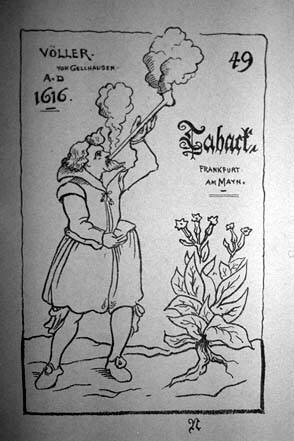Smoking pipe
|
|
- This article describes a pipe used for smoking. For other uses of the term, see pipe.
A smoking pipe is a device used for smoking combustible substances such as tobacco. The smoking pipe typically consists of a small chamber (the bowl) for the combustion of the substance to be smoked and a thin stem (shank) that ends in a mouthpiece (also called a bit).
Pipes are made from a variety of materials, the most common being (in order of use): briar, corncob, meerschaum, African block meerschaum, clay, cherry, wood, glass, gourd, and various other materials, such as morta. Glass pipes in particular have become an art form.
Tobaccos used for smoking pipes are often carefully treated and blended to achieve flavour nuances not available in other tobacco products. Many of these are blends using staple ingredients of variously cured Burley and Virginia tobaccos which are enhanced by spice tobaccos, among them many Oriental or Balkan varietals, Latakia (a fire-cured spice tobacco of Cypriot or Syrian origin), Perique (uniquely grown in St. James Parish, Louisiana) or blends of Virginia and Burley tobaccos of African, Indian, or South American origins. Traditionally, many U.S. blends are made of American Burley flavoured with aromatic ingredients to produce "sweeter" smokes whereas "English"-style blends are based on natural Virginia tobaccos enhanced only by Oriental varietals. There is a growing tendency towards "natural" tobaccos which derive their aromas from artful blending with selected spice tobaccos only and careful, often historic, curing processes. Pipes can range from the very simple machine-made briar pipe to highly-prized handmade and artful implements by renowned pipemakers which are priced as very expensive collector's items.
| Contents |
Materials and Construction
Pipa_savinelli.jpg
The material and shape of a pipe has a profound influence upon the aesthetic of a smoke.
Briar
The majority of pipes sold today, whether hand made or machine made, are fashioned from briar. Briar is cut from the root burl of the Tree heath (Erica arborea), which is native to the rocky and sandy soils of the Mediterranean region. While briar is the most widely used -- and perhaps best known -- pipe making material, pipes of other woods and other materials are also available.
Meerschaum
Meerschaum (hydrated magnesium silicate), a mineral found in small shallow deposits mainly around the city of Eskesehir in central Turkey, is prized for its plasticity which allows it to be carved into many decorative and figural shapes. It has been used since the 17th century and, with clay pipes, represented the most common medium for pipes before the introduction of briar as the material of choice in the 19th century. The word "meerschaum" means "sea foam" in German, alluding to its natural white color. However, meerschaum is a very porous mineral that absorbs elements of the tobacco during the smoking process, and gradually changes color to a golden brown. Old, well-smoked meerschaum pipes are prized for their distinctive coloring.
Clay
Clay in this case is almost always a very fine white clay. Low-quality "clay" pipes are actually made from porcelain slip poured into a mold. These are porous, of very low quality, and impart unwanted flavors to a smoke. Top-notch clays, on the other hand are made in a labor-intensive process that requires beating all air out of the clay, hand-rolling each pipe before molding it, piercing with a fine wire, and careful firing. Traditionally, clay pipes are un-glazed. Clays burn "hot" in comparison to other types of pipes, so they are often difficult for most pipe-smokers to use. Their proponents claim that, unlike other materials, a well-made clay pipe gives a "pure" smoke, with no flavor addition from the pipe bowl.
Calabash
Calabash gourds (usually with meerschaum or porcelain bowls set inside them) have long made prized pipes, but they are labour-intensive and nowadays quite expensive.
The construction of a Calabash pipe generally consists of a downward curve that ends with an upcurve where the tobacco is held. This low center of gravity allows for the user to easily hold the pipe by the mouth alone, leaving his hands free. This advantage was often used by actors who wanted to depict their character smoking while permitting them to do other business simultaneously. That is why the character Sherlock Holmes, who never used this kind of pipe in the stories, is stereotypically depicted as favoring it because early dramatic productions, especially those starring William Gillette made this artistic decision.
Corncob
On the other end of the scale, "corncob" pipes made from maize cobs are cheap and effective, even if some regard them as inelegant. The cobs are first dried for two years. Then they are hollowed out to make a bowl shape. The bowls are dipped in a plaster-based mixture and varnished or laquered on the outside. Shanks made from Pine wood are then inserted into the bowls. The first and largest manufacturer of corncob pipes is Missouri Meerschaum, located in Washington, Missouri in the USA [1] (http://www.corncobpipe.com/). Missouri Meerschaum has produced the pipes since 1869. General Douglas MacArthur was perhaps the most famous smoker of this type of pipe, along with the cartoon character Popeye.Corncob pipes remain popular today because they are inexpensive and require no "break-in" period like briar pipes. For these two reasons, corncob pipes are often recommended as a "Beginners pipe." But, their enjoyment is by no means limited to beginners. Corncob pipes are equally valued by both learners, and experienced smokers who simply desire a cool, clean smoke.
Glass
Hand-blown glass pipes are one of the most common kinds of hand-blown glass today. They can be quite elaborate. One reason for their appeal is that since the glass is completely inert, it does not affect the flavor of the smoke. The glass is normally colored but not opaque, and as the pipe is used, the colors darken and become richer. They tend to have a small hole on the side which can be covered by a finger for a stronger smoke, or uncovered to allow a small amount of air to mix with the smoke for cooling. Due to their lack of porousity and tendency to retain heat, glass pipes are usually used to smoke substances other than tobacco.
Apple
Fruits such as apples have been used as material for an expedient pipe.
Lesepfeife.jpg
Health concerns for tobacco smokers
While tobacco smoke from pipes contains less of the carcinogenic substances found in cigarette smoke, it is nonetheless a health hazard, leading more often to cancers of the mouth and throat rather than the lungs. Addiction to nicotine is rarely involved unless the smoke is inhaled at a consumption rate comparable to heavy cigarette smoking. A 1964 study once showed that pipe smokers on average lived marginally longer than the general population, but that study failed to control for social factors and did not include an adequate representation of pipe smokers to be considered sound. Pipe smokers are inclined to attribute this to the calming, contemplative mindset promoted by the ritualistic character of pipe use.
A recent American Cancer Society study finds pipe smoking confers a significantly lower risk of cancer and other similar disease as compared to cigarette smoking, though the risks are still considerably higher than for non-smokers.
- S. Jane Henley, Michael J. Thun, Ann Chao, and Eugenia E. Calle. (2004). "Association Between Exclusive Pipe Smoking and Mortality From Cancer and Other Diseases (http://www.jncicancerspectrum.oupjournals.org/cgi/content/abstract/jnci;96/11/853)". Journal of the National Cancer Institute 96, 853–861.
See also
External links
- How to Pack and Light a Pipe (http://www.smokingpipes.com/information/howto/packing.cfm)
- Drugs-plaza about Pipes & Bongs (http://www.drugs-plaza.com/marijuana/pipes_and_bongs.htm)
- Hand blown color changing glass pipes and water bongs (http://www.glass-pipes-water-bongs.com/)
- The Professor's Pipe Tobacco Reviews (http://pipes.priss.org/)
- Alt.Smokers.Pipes homepage (http://www.aspipes.org/)
- Tobacco Reviews (http://www.tobaccoreviews.com/)
- OoOPS Famous Pipe Smokers List (http://fujipub.com/ooops/famous.html)fr:Pipe
de:Tabakspfeife es:Pipa (de fumar) it:Pipa ja:ã¿ãã³#.E3.83.91.E3.82.A4.E3.83.97 nl:Pijp (rookgerei) pt:Cachimbo fi:Piippu
he:מקטרת



